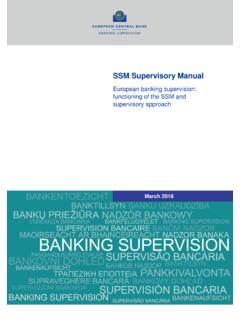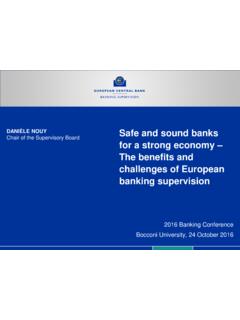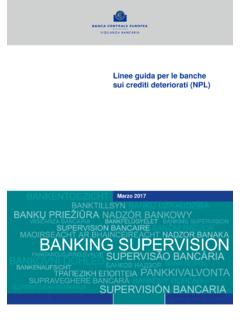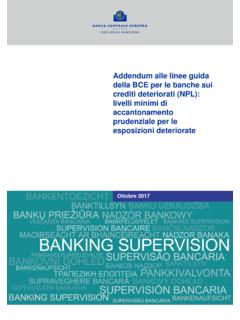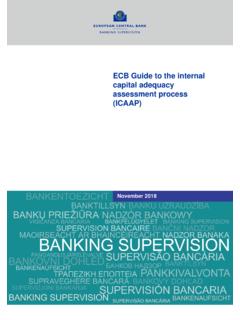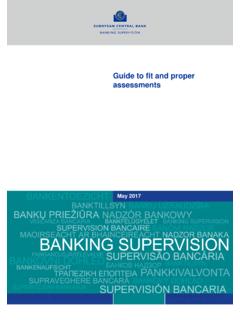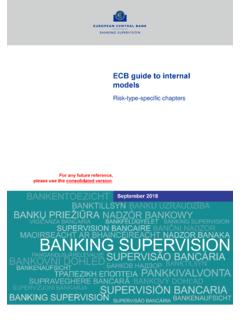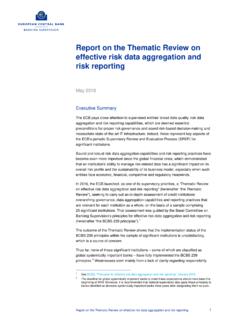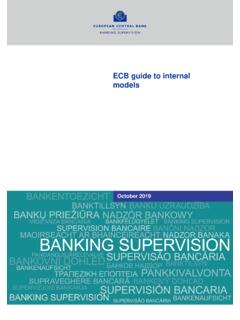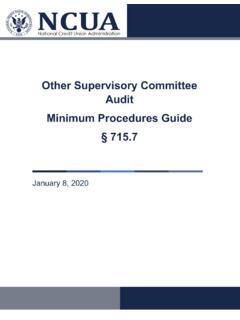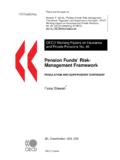Transcription of Supervisory expectations relating to risk management and ...
1 Guide on climate-related and environmental risks Supervisory expectations relating to risk management and disclosure November 2020 Guide on climate-related and environmental risks 1 Contents 1 Introduction 3 2 Scope and application 6 Application to significant institutions 6 Date of application 7 Application to less significant institutions 7 General prudential framework 7 3 Climate-related and environmental risks 10 Definitions 10 Characteristics of climate-related and environmental risks 10 Observations from stocktakes 14 4 Supervisory expectations relating to business models and strategy 16 Business environment 16 Business strategy 18 5 Supervisory expectations relating to governance and risk appetite 21 management body 21 Risk appetite 24 Organisational structure 26 Reporting 29 6 Supervisory expectations relating to risk management 31 Risk management framework 31 Credit risk management 35 Operational risk management 38 Market risk management 40 Scenario analysis and stress testing 42 Liquidity risk management 43 Guide on climate-related and environmental risks 2 7 Supervisory
2 expectations relating to disclosures 45 Disclosure policies and procedures 45 Content of climate-related and environmental risk disclosures 48 References 51 Guide on climate-related and environmental risks 3 1 Introduction Following the adoption of the Paris Agreement on climate change1 and the UN 2030 Agenda for Sustainable Development in 2015, governments are making strides to transition to low-carbon and more circular economies on a global scale. On the European front, the European Green Deal sets out the objective of making Europe the first climate-neutral continent by 2050.
3 The financial sector is expected to play a key role in this respect, as enshrined in the Commission action plan on financing sustainable growth. Transitioning to a low-carbon and more circular economy entails both risks and opportunities for the economy and financial institutions,2 while physical damage caused by climate change and environmental degradation can have a significant impact on the real economy and the financial system. For the second year in a row, the European Central Bank (ECB) has identified climate-related risks as a key risk driver in the SSM Risk Map for the euro area banking system.
4 The ECB is of the view that institutions should take a strategic, forward-looking and comprehensive approach to considering climate-related and environmental risks . The ECB is closely following developments that are likely to affect euro area institutions. The Commission action plan on financing sustainable growth aims to redirect financial flows to sustainable investments, to mainstream sustainability in risk management and to enhance transparency and long-termism. Specifically for the banking sector, the European Banking Authority (EBA) was given several mandates to assess how environmental, social and governance (ESG) risks can be incorporated into the three pillars of prudential supervision.
5 Based on this, the EBA published an Action Plan on sustainable finance and a Discussion Paper on the integration of ESG risks into the regulatory and Supervisory framework. This guide outlines the ECB s understanding of the safe and prudent management of climate-related and environmental risks under the current prudential framework. It describes how the ECB expects institutions to consider climate-related and environmental risks as drivers of existing categories of risk when formulating and implementing their business strategy and governance and risk management frameworks.
6 It further explains how the ECB expects institutions to become more transparent by enhancing their climate-related and environmental disclosures. This guide is not binding for the institutions, but rather it serves as a basis for Supervisory dialogue. As part of this Supervisory dialogue, the ECB will discuss with institutions the ECB s expectations set out in this guide in terms of any possible divergences in institutions practices. The ECB will continue to develop its Supervisory 1 Similarly, and following the Global Assessment by the Intergovernmental Science Policy Platform on Biodiversity and Ecosystem Services (IPBES), additional international agreements are expected under the UN Convention on Biological Diversity to promote the sustainable use of ecosystems and reduce the causes of biodiversity loss.
7 2 See, for example, ECB Financial Stability Review May 2019. Guide on climate-related and environmental risks 4 approach to managing and disclosing climate-related and environmental risks over time, taking into account regulatory developments, as well as evolving practices in the industry and in the Supervisory community. Box 1 Overview of ECB Supervisory expectations 1. Institutions are expected to understand the impact of climate-related and environmental risks on the business environment in which they operate, in the short, medium and long term, in order to be able to make informed strategic and business decisions.
8 2. When determining and implementing their business strategy, institutions are expected to integrate climate-related and environmental risks that impact their business environment in the short, medium or long term. 3. The management body is expected to consider climate-related and environmental risks when developing the institution s overall business strategy, business objectives and risk management framework, and to exercise effective oversight of climate-related and environmental risks . 4. Institutions are expected to explicitly include climate-related and environmental risks in their risk appetite framework.
9 5. Institutions are expected to assign responsibility for the management of climate-related and environmental risks within the organisational structure in accordance with the three lines of defence model. 6. For the purposes of internal reporting, institutions are expected to report aggregated risk data that reflect their exposures to climate-related and environmental risks with a view to enabling the management body and relevant sub-committees to make informed decisions. 7. Institutions are expected to incorporate climate-related and environmental risks as drivers of existing risk categories into their existing risk management framework, with a view to managing, monitoring and mitigating these over a sufficiently long-term horizon, and to review their arrangements on a regular basis.
10 Institutions are expected to identify and quantify these risks within their overall process of ensuring capital adequacy. 8. In their credit risk management , institutions are expected to consider climate-related and environmental risks at all relevant stages of the credit-granting process and to monitor the risks in their portfolios. 9. Institutions are expected to consider how climate-related and environmental events could have an adverse impact on business continuity and the extent to which the nature of their activities could increase reputational and/or liability risks .
